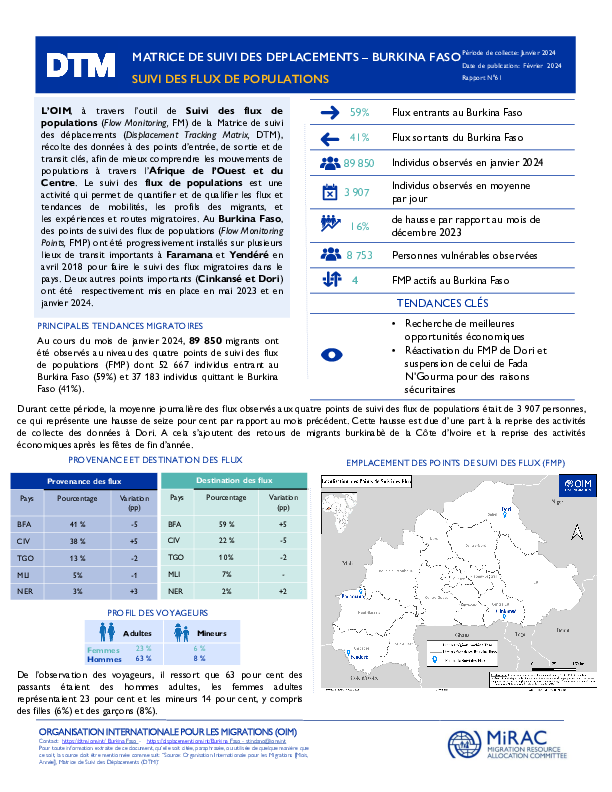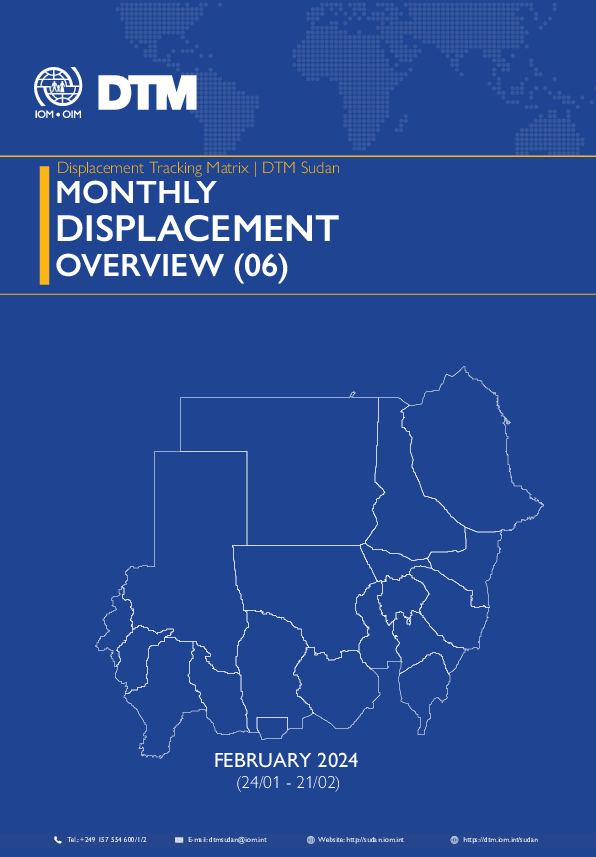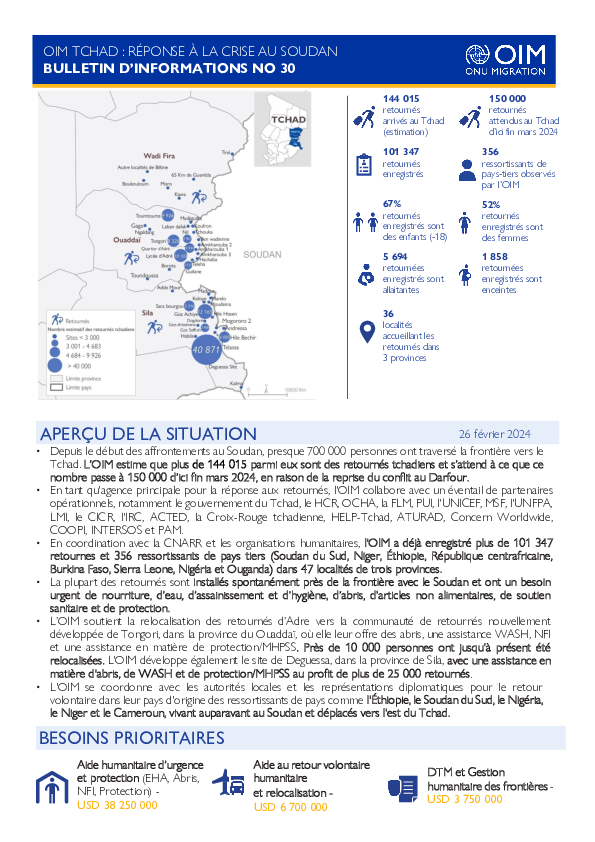-
Countries
-
Data and Analysis
-
Special Focus
-
Crisis Responses

Contact
DTM Burkina Faso, BFInformationUnit@iom.int
Language
French
Location
Burkina Faso
Period Covered
Jan 01 2024
Jan 31 2024
Activity
- Flow Monitoring
L’OIM, à travers l’outil de Suivi des flux de populations (Flow Monitoring, FM) de la Matrice de suivi des déplacements (Displacement Tracking Matrix, DTM), récolte des données à des points d’entrée, de sortie et de transit clés, afin de mieux comprendre les mouvements de populations à travers l’Afrique de l’Ouest et du Centre. Le suivi des flux de populations est une activité qui permet de quantifier et de qualifier les flux et tendances de mobilités, les profils des migrants, et les expériences et routes migratoires. Au Burkina Faso, des points de suivi des flux de populations (Flow Monitoring Points, FMP) ont été progressivement installés sur plusieurs lieux de transit importants à Faramana et Yendéré en avril 2018 pour faire le suivi des flux migratoires dans le pays. Deux autres points importants (Cinkansé et Dori) ont été respectivement mis en place en mai 2023 et en janvier 2024.

Contact
DTM Sudan, DTMSudan@iom.int
Language
English
Location
Sudan
Period Covered
Jan 24 2024
Feb 21 2024
Activity
- Mobility Tracking
- Baseline Assessment
Overview
IOM DTM Sudan presents its sixth Monthly Displacement Overview. This publication provides an account of Sudan’s displacement context since 15 April 2023 – outlining population mobility and displacement, as well the present and evolving needs of IDPs across Sudan.
Rationale
Recognizing the need for more detailed insights into the IDP situation, including the priority needs, access to services, movement intentions, and demographic breakdowns of the affected population, DTM Sudan has undertaken a comprehensive review of our data collection tool. In collaboration with a wide range of internal and external stakeholders, we have developed a new tool to better inform humanitarian response operations, aligning with the DTM global methodology. Leveraging our extensive network of approximately 367 field-based enumerators and a robust system of over 3,266 key informants across the country, DTM gathered data on IDPs across 6,845 locations, in 179 of Sudan’s 189 localities, across all of Sudan’s 18 states, during February 2024.
Key Findings
- DTM Sudan estimates that 6,326,416 individuals (1,261,060) households) have been recently internally displaced.
- IOM DTM also reports that an estimated 1,884,909 mixed cross-border movements have been made into neighbouring countries.
- Since 15 April 2023, 46 per cent of the IDP caseload sought refuge in the Darfur and Kordofan regions, whereas 53 per cent were observed across the Northern, Eastern, and Central states.
- The majority of the IDP caseload (66%) were seeking shelter with the host community.
- While food remains the highest priority need, health and non-food items are also growing concerns.

Contact
ROPretoriaRMDHub@iom.int
Language
English
Location
Malawi
Period Covered
Jan 01 2024
Jan 31 2024
Activity
- Flow Monitoring
This report is an overview of the data collected from 1 to 31 January 2024 at Mangochi FMP in Malawi along the border with Mozambique and Karonga FMP in Malawi along the border with the United Republic of Tanzania. The Flow Monitoring Registry (FMR) collects data at Flow Monitoring Points (FMPs) through direct observation and interviews with key informants, including staff working at transit stations, border patrol officers, local authorities, bus or taxi drivers and travellers themselves. The FMR gathers data on the number of travellers crossing FMPs, as well as the provenance, next destination, vulnerabilities and means of transport of travellers.

Contact
DTMMozambique@iom.int
Language
English
Location
Mozambique
Period Covered
Feb 08 2024
Feb 27 2024
Activity
- Mobility Tracking
- Event Tracking
Between 22 December 2023 to 27 February 2024, sporadic attacks and fear of attacks by Non-state Armed Groups in Macomia, Chiure, Mecufi, Mocimboa da Praia, and Muidumbe triggered the cumulative displacement 81,721 individuals/17,591 families. [For more see Emergency Tracking Online Dashboard]. The current Movement Alert #102 reports on recent attacks recorded in Chiure, Macomia, and Mecufi between 8 to 27 February that displaced 68,156 individuals.

Contact
DTM Chad, dtmtchad@iom.int
Language
French
Location
Chad
Period Covered
Feb 15 2024
Feb 24 2024
Activity
- Mobility Tracking
- Event Tracking
• Depuis le début des affrontements au Soudan, presque 700 000 personnes ont traversé la frontière vers le Tchad. L’OIM estime que plus de 144 015 parmi eux sont des retournés tchadiens et s’attend à ce que ce nombre passe à 150 000 d’ici fin mars 2024, en raison de la reprise du conflit au Darfour.
• En tant qu'agence principale pour la réponse aux retournés, l'OIM collabore avec un éventail de partenaires opérationnels, notamment le gouvernement du Tchad, le HCR, OCHA, la FLM, PUI, l'UNICEF, MSF, l'UNFPA, LMI, le CICR, l'IRC, ACTED, la Croix-Rouge tchadienne, HELP-Tchad, ATURAD, Concern Worldwide, COOPI, INTERSOS et PAM.
• En coordination avec la CNARR et les organisations humanitaires, l'OIM a déjà enregistré plus de 101 347 retournes et 356 ressortissants de pays tiers (Soudan du Sud, Niger, Éthiopie, République centrafricaine, Burkina Faso, Sierra Leone, Nigéria et Ouganda) dans 47 localités de trois provinces.
• La plupart des retournés sont installés spontanément près de la frontière avec le Soudan et ont un besoin urgent de nourriture, d’eau, d’assainissement et d’hygiène, d’abris, d’articles non alimentaires, de soutien sanitaire et de protection.
• L’OIM soutient la relocalisation des retournés d’Adre vers la communauté de retournés nouvellement développée de Tongori, dans la province du Ouaddaï, où elle leur offre des abris, une assistance WASH, NFI et une assistance en matière de protection/MHPSS. Près de 10 000 personnes ont jusqu’à présent été relocalisées. L'OIM développe également le site de Deguessa, dans la province de Sila, avec une assistance en matière d'abris, de WASH et de protection/MHPSS au profit de plus de 25 000 retournés.
• L'OIM se coordonne avec les autorités locales et les représentations diplomatiques pour le retour volontaire dans leur pays d'origine des ressortissants de pays comme l'Éthiopie, le Soudan du Sud, le Nigéria, le Niger et le Cameroun, vivant auparavant au Soudan et déplacés vers l'est du Tchad.

Contact
DTM Chad, dtmtchad@iom.int
Language
English
Location
Chad
Period Covered
Feb 15 2024
Feb 24 2024
Activity
- Mobility Tracking
- Event Tracking
• Nearly 700,000 people have crossed into Chad since the onset of the crisis in Sudan. IOM estimates that more than 144,015 among them are Chadian returnees and expects this number to rise to 150,000 by the end of March 2024, due to ongoing conflict in Darfur.
• IOM, as the lead agency for the returnee response, collaborates with a range of operational partners including the Government of Chad, UNHCR, OCHA, LWF, PUI, UNICEF, MSF, UNFPA, LMI, ICRC, IRC, ACTED, the Chadian Red Cross, HELP-Tchad, ATURAD, Concern Worldwide, COOPI, INTERSOS, and WFP.
• In coordination with CNARR and humanitarian organizations, IOM has registered 101,347 returnees and identified 356 third-country nationals (from South Sudan, Niger, Ethiopia, the Central African Republic, Burkina Faso, Sierra Leone, Nigeria, and Uganda) in 47 localities in three provinces.
• Most of the returnees currently live in spontaneous locations near the border and are in urgent need of food, water, sanitation and hygiene, shelter, household items, health, and protection.
• IOM is relocating returnees from Adre to the newly developed returnee community of Tongori, Ouaddaï province, where it offers them shelters, WASH, NFI, and Protection/MHPSS assistance. Over 11,000 individuals have so far been relocated. IOM is also developing the site of Deguessa, Sila province, with shelter, WASH, and Protection/MHPSS assistance for the benefit of over 25,000 returnees.
• IOM is coordinating with local authorities and diplomatic representations for the voluntary return to their home countries of third-country nationals (TCNs) from countries including Ethiopia, South Sudan, Nigeria, Niger, and Cameroon previously living in Sudan and displaced to eastern Chad.

Contact
dtmlebanon@iom.int
Language
English
Location
Lebanon
Period Covered
Oct 10 2023
Feb 27 2024
Activity
- Mobility Tracking
- Baseline Assessment
Since October 8 there has been an increase in cross-border incidents between Israel and Lebanon, resulting in the displacement of people both within the South and elsewhere within the country. Since October 10, the Displacement Tracking Matrix (DTM) has been conducting the daily monitoring of population movements. The objective of the exercise is to inform preparedness and response planning.

Contact
DTMAfghanistan@iom.int
Language
English
Location
Afghanistan
Period Covered
Feb 18 2024
Feb 24 2024
Activity
- Survey
- Flow Monitoring Survey
- Flow Monitoring
IOM Afghanistan's DTM Flow Monitoring activity, initiated at the beginning of 2024, seeks to quantify and better understand the mobility dynamics at Afghanistan’s borders. On 10 January 2024, DTM began deploying field teams at four border crossing points with the Islamic Republic of Iran (IRN) and Pakistan (PAK), expanding to another border crossing point Ghulam Khan as of 11 February (see map below for the locations of all five crossing points), to conduct two interlinked exercises. The first is a headcount of all individuals entering or leaving Afghanistan (including returnees), also called Flow Monitoring Counting (FMC), to gauge flow volume. The second is a survey of randomly selected Afghan national individuals or groups entering or leaving Afghanistan, also called the Flow Monitoring Survey (FMS), to understand the profiles, motivations, and vulnerabilities of the target population. This snapshot provides key findings combining various IOM data sources, including DTM Afghanistan’s FMC and FMS activities, DTM Pakistan’s Flow Monitoring of Afghan returnees, and IOM Afghanistan’s Cross-Border Post-Arrival Humanitarian Assistance (CB-PAHA) program, for the period 18 to 24 February 2024. For more information about methodology, see the section in the last page of this report titled “IOM INFLOW DATA.”

Contact
DTM Ethiopia, DTMEthiopia@iom.int
Language
English
Location
Ethiopia
Period Covered
Aug 01 2023
Sep 02 2023
Activity
- Mobility Tracking
- Site Assessment
- Village Assessment
Between August and September 2023, the International Organization for Migration (IOM) Data and Research Unit (DRU), through its Displacement Tracking Matrix (DTM) methodology, deployed the Site Assessment (SA) and Village Assessment Survey (VAS) tools to assess the mobility, needs and vulnerabilities of Internally Displaced Persons (IDPs) and returning IDPs across Ethiopia. This snapshot report will present key findings on needs and vulnerabilities, in particular those related to Cash and Voucher (CVA) assistance.
It is recommended to utilize cash and mixed modality (cash + in-kind) responses for these population groups if feasible. The finding that 80.5% of sites and 75.7% of villages mentioned a preference towards cash, whether by itself or mixed with in-kind/baskets, aligns with Ethiopia Cash Working Group (CWG) recommendations based on joint CVA feasibility assessments.

Contact
Niger Migration Data and Research Unit - nigerdataresearch@iom.int
Language
French
Location
Niger
Period Covered
Dec 01 2023
Dec 31 2023
Activity
- Survey
- Displacement Solutions
- Mobility Tracking
La région de Diffa, située dans le bassin du lac Tchad, fait face à une crise humanitaire grave en raison du conflit en cours et des attaques de groupes armés non étatique (GANE) non étatique. Cette situation a provoqué d'importants déplacements de populations et une détérioration des conditions de vie. Les déplacés internes, les réfugiés et les communautés d'accueil sont confrontés à des défis majeurs tels que l'accès restreint à l'eau potable, à la nourriture, aux soins de santé et à l'éducation. Les organisations humanitaires s'efforcent activement de répondre à ces besoins urgents en fournissant une aide vitale, en soutenant les infrastructures locales et en protégeant les droits des personnes touchées. Cependant, la situation demeure préoccupante et nécessite une attention continue ainsi que des ressources supplémentaires pour atténuer les souffrances et trouver des solutions durables.
Afin de trouver des solutions durables aux déplacements internes et de prévenir de nouveaux déplacements dans la région, il est crucial de comprendre les niveaux de stabilité dans les zones accueillant les populations déplacées. L'Organisation internationale pour les migrations (OIM) a introduit l’indice de solution et de mobilité (ISM) en 2019 pour évaluer la stabilité des zones accueillant les rapatriés ou les populations déplacées dans le bassin du lac Tchad (BLC). Cet indice vise à identifier les facteurs qui influent sur la stabilité d'un lieu afin de déterminer les interventions prioritaires pour la transition et le rétablissement, renforçant ainsi la résilience et la stabilité dans une région marquée par les conflits et les déplacements. L’ISM mesure les perceptions de stabilité et analyse les facteurs influençant les décisions des populations de rester ou de se déplacer. Il fournit un outil permettant aux autorités et aux partenaires de développer des stratégies plus efficaces, de prioriser les ressources et de planifier les interventions dans les zones fragiles et instables, en intégrant des approches humanitaires, de relèvement et de stabilisation. Ce rapport présente les résultats du cinquième cycle de collecte de données de l’ISM, réalisé entre le 18 novembre et le 8 décembre 2023 dans la région de Diffa, au Niger.